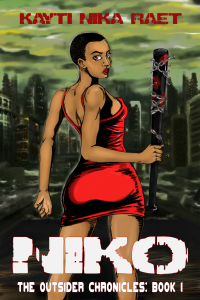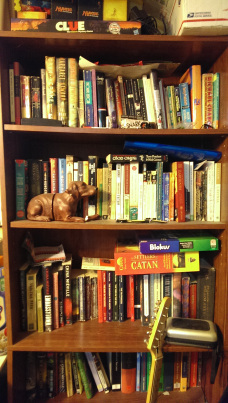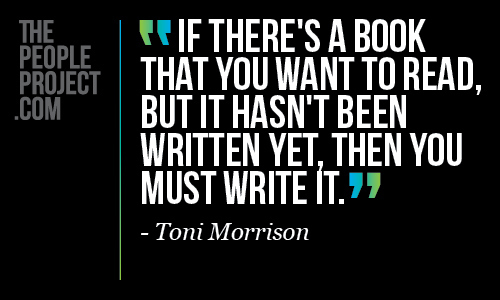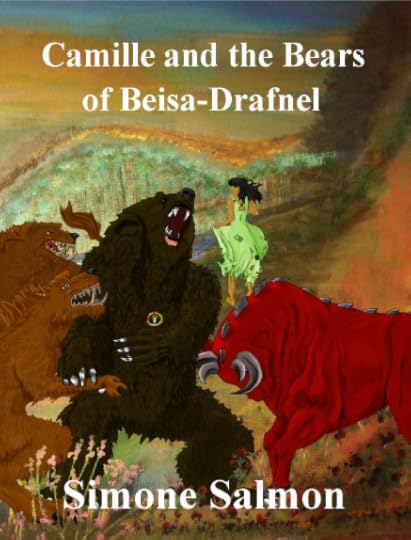B.R. Sanders's Blog, page 22
August 19, 2015
Stories Are Social

I was lucky enough to participate in last week’s episode of Radio Z. In case you missed it, the episode’s theme was building an audience through an author website. The episode had loads of practical advice—so definitely check out the recording if you’re thinking about starting a website or if you’re thinking about tweaking your own—but what I found most interesting about the conversation was the idea that while reading itself is generally a solitary act1 stories are social.

missed the show? you can check out the recording here!
Stories have always been social. Long before people wrote them down, they had to be social, otherwise they would wither and die. Stories are rooted in oral traditions, in song and recitation, in epic poetry. I write novels, mostly, but novels wouldn’t exist without the undergirding of these oral traditions—the exchange of words around hearths from long ago.
We think of books as an introvert’s game, and to some extent that’s true. I am certainly an introvert. Writing and reading are a kind of solace to me, and introvert’s balm. I’m sure you know what I mean: the quiet, the little protective bubble a book casts around you. “This person is reading,” an open book says on public transit, “do not engage.”2
But what happens after the book is done? I can only speak for myself, but if it’s a good book, there’s a flurry of social activity. I start cramming it into people’s hands. “Have you read X? You should read X! You’ll love it.” There are facebook posts. I review it on my blog. There is tweeting, likely WITH GRATUITOUS CAPSLOCKING. A multitude of gchats with friends across the country. I scour other people’s reviews and reflect on my own experience reading the book. Sometimes, I might even engage with the author on social media, my fingers bent over my phone, biting my lip in anticipation of what they might say to me next.
Books, I’d argue (and I’m not the first to argue this, not by a long shot) are still social. They are just social in a different way. I was talking to my partner, Jon, about how grateful I am that I have built a website and that I have started building a presence on twitter because it’s led me to a community of people who value the same things I do in books. “You need that,” he said. “As long as I’ve known you3 you’ve needed people to talk to about books in really, really gory passionate detail. And I just can’t read fast enough to keep up with you. This is really good for you.”
He’s right. It is really good for me.
~1Except for those time back in high school where you were forced to read aloud round-robin style, which was always, always hella awkward.
2Sadly, this doesn’t always work, but it works at least some of the time.
3Which is my entire adult life, FYI. We met when we were eighteen.


August 18, 2015
Interview: KAYTI NIKA RAET
I’m excited to have Kayti Nika Raet stop by my blog today and answer a few questions about her novel, Niko, the first installment of the Outsider Chronicles!
Originally from Brooklyn, New York, Kayti Nika Raet moved down South when she was 11, where she was bitten by the writing bug, as well as other, less friendly insects.
She is the author of the Outsider Chronicles, a five book series starting with NIKO and set in a world where the rain burns like acid and flesh eating monsters roam.
She’s also a reviewer for Readers’ Favorite and has her own Youtube Channel: Kayti Edition.
When she is not hard at work on her fourth book she has fun reading, listening to K-pop, and photography.
Kayti lives in Milledgeville, Georgia.

The worldbuilding in NIKO is meticulous, and the fact that it’s the first in a series suggest that what’s been revealed about the Slithers, Amaryllis city, the Circles, the acid rain, etc, is only the tip of the iceberg. Did you plan the arc of the entire series before you wrote NIKO, or did you figure out it was a series as you wrote the first book?
Thank you! :) I started Niko wanting it to be a series. It was actually one of my writing goals since I sucked at sequels, and what’s a series if not multiple sequels? But I’m a total pantser who hates outlines (hisssss), so the first draft was written without any concrete ideas for a series arc. I was just writing a story and having loads of fun.
It wasn’t until I started doing the second and third draft that I hashed out a vague arc (seriously, it’s about five words) that I wouldn’t feel constricted by. Each book has it’s own individual arc that helps keep me on course. Mostly.
It’s been a learning experience. I’m not only finding out new things about my characters with each book, but I’m also discovering things about myself as a writer.
~
Where did the initial idea for NIKO come from? How did you get the idea for the series?
There’s no one, concrete, idea that got Niko going, it was a lot of little things coming together. A doodle with the word Harmony Nickle on it. A love of squicky, gory, weird you out horror. A dislike for the slew of YA that seemed to encourage girls to belittle themselves, and be ‘likable’ and ‘relatable’. My twisted sense of humor. Manga and action movie fangirling. Random song lyrics… and science facts… and randomness… But at the core of it all was the desire for a story that I would want to read. Hopefully it’s something that lots of other people like reading too.
~
I haven’t had a chance to pick up the rest of the book yet but PLEASE tell me we haven’t seen the last of Norm and Lo!
They’re great aren’t they?
Did you know, Lola Pon is named after the amazing authors Malinda Lo and Cindy Pon?
*mild fan girl moment*
Unfortunately, I haven’t had a chance to properly reintroduce them yet, but I plan to.
I love them.
~
What are you working on right now? What should readers look for from you next?
Right now, I’m taking a little break to relax and recharge before diving into the big finale that is book 5. I have a slight idea how I want things to go and I can’t wait to get started.
There have been a few other stories buzzing around in my head as well, but they’ve been a little evasive when it comes to the getting word on paper part.
~
How can readers stay in the loop and get news about your projects and releases?
I’m everywhere (okay, that’s a lie. But I’m ALMOST everywhere. Close enough.)
You can follow me on
Twitter: https://twitter.com/knrwrites
Facebook: https://m.facebook.com/kaytinikaraetbooks
My blog that I really need to update more often: http://kaytinikaraet.com
My second blog with the two lovely authors Madhuri Blaylock and L. J. K. Oliva #WriteBitch4Life
http://writebitches.com
~
Anything else you want us to know? Shout-outs? Words of wisdom?
Oh my god, shout outs! I’ll curb my enthusiasm and keep it to three authors you definitely should read.
Madhuri Blaylock made the dedication of one of my books and if you read any of her works you’ll see why. She’s the author of The Sanctum Trilogy and the upcoming Keepers Series with the first book, DUTCH about to set the world on fire.
Kendall Bailey really came through with some awesome editing and helped beef up some of the sci-fi elements in NIKO. He wrote a great crime thriller called The Dead Don’t Speak.
Suanne Laqueur is someone I bumped into recently, and her book The Man I Love is all kinds of awesome. I don’t usually read contemporary romances, but that book… asdfghjkl!
And for the words of wisdom bit, I’m going to crib from one of the greats.
Want posts like this delivered to your inbox? Sign up for my newsletter!


August 17, 2015
Roundup: August 10-16, 2015
Wanderings on the Internet
Didn’t get a chance to listen to me on Radio Z live? No worries! The episode is recorded for posterity here; listen to it anytime.
Weekend twitter chats! Man, I love a good twitter chat.
#WO2016 hosted a chat on magic in fantasy. We talked about our favorite books, writing tips, magic systems, etc. Scan through the tag for some really good book recs and more!
#WeNeedDiverseBlogs hosted a chat about networking with other book bloggers and finding resources. Soooo many great people to follow!
If you are so inclined, browse the Supernatural Haikus.
Writing Update
4,400 more words added to The Search, too, which brings us up to 92K total so far. The end of Draft 1 is in sight, friends–probably 10-15k words away? Will need beta readers soon.
Want posts like this delivered to your inbox? Sign up for my newsletter!


August 14, 2015
Book Review: NIKO
Notes on Diversity:
This book is packed with diversity. It is Diverse with a capital D. The main character is a take-no-shit suffer-no-fools Black teenager, and most of the people around her are other people of color, too: brown folks, East Asian people, South Asian people, they run the gamut. There are kickass queer characters. There are characters with disabilities. Class issues are on display. Diversity is truly firing on all cylinders in Niko.
Honestly, the author’s attention to issues of diversity in both the characters and the worldbuilding is what moved this from a 3 star to a 4 star rating. It wasn’t only that diversity was present, but how it was woven into the overall book: there is great nuance present here that shows that Kayti Nika Raet thought long and hard about how diversity in fiction ought to be represented. The racial and gender diversity, for example, was presented without comment. The issues of disability became plot threads, things to dissect. Very well done.
Review:
FTC disclosure: I received a free digital copy of this book in exchange for an honest and unbiased review.
Harmony Niko is seventeen years old and trapped in a nightmarish post-apocalyptic wasteland full of pseudo-human monsters called Slithers that want to eat her and acidic rain that will kill her if she does not find shelter from it. She is responsible for keeping herself and her two younger brothers alive. But while out on a foraging run everything falls apart–she comes back to find her dilapidated house in flames, her youngest brother dead, and her remaining brother missing. She wakes up in Amaryllis city, now part of a circle of Slither killers.
Once in Amaryllis city, Niko’s world falls apart. Things she took for granted–that Slithers can be easily killed with the right weaponry and good luck, that clean water is precious and must be hoarded–are suddenly called into question. Niko struggles to find her place in the Rose Circle, the group of Slither killers who have adopted her, while trying to process all the new information thrown at her. At the same time, she forms a plan to get back outside Amaryllis and find her lost brother.
Kayti Nika Raet anchors the plot on Niko. As an author, she places all her eggs in one basket. Niko as a character is fully realized, possessing a broad range of emotionality and a strong, driving voice that carries the narrative forward. Niko is intense, observant and suspicious. She is shaken and vulnerable and ferocious. She is a lone wolf and a caretaker. Raet writes Niko with lovely subtlety, letting her grow and stretch over the course of the book. Niko at the end of the book is very different than she was at the beginning. She is still very much herself, but the course of events has marked her, and she is changed.
It is probably obvious that I connected to Niko’s character. Every beat of Niko’s character felt true for me because I was so much like Niko at eighteen: lost, full of bravado, failing an even more lost younger sibling, coping with unnamed and unrecognized PTSD. Raet’s writing captured a resiliency and a woundedness that is utterly complex, at once strong enough to keep going and also weak enough to be self-destructive. And, at the same time, the book is full of science fiction conceits that are intriguing. The hints dropped about the weird, haunting, body-horror Slither monsters are not resolved in this book, and are definitely interesting enough to keep me hooked. I’ll be picking up the next installment, Harm.
Most of the other characters lacked Niko’s complexity, which was one weak spot in the book. Malik, one leg of a very light love triangle, shows some depth, and as a set Norm and Lo were definitely interesting, but most of the other characters blended together. Perhaps as an extension, there are scenes where the action is somewhat unclear. Raet’s writing is typically very crisp, but sometimes I had to reread sentences to glean what happened when several characters were interacting around Niko. A less dedicated reader may have skimmed or skipped those sections altogether. One section where this happened actually turned out to be important plot-wise, but I initially missed who had upset who.
Bottom line, though, I really, really enjoyed this book. It was a fast and brutal and brilliant read, just like Niko herself. When I found out there were three other books in the series already I wanted to clear my schedule and read them all back to back.
Want posts like this delivered to your inbox? Sign up for my newsletter!


August 13, 2015
Check me out on Radio Z!
Hi folks! I’ll be chatting on Radio Z this Sunday, 8/16/2015, at 4pm PST about growing a diverse audience through blogs (you know, like this one). It’ll be a fun conversation, and informative, too. So stop by for your weekly dose of edutainment!


August 12, 2015
No More Room At the Inn: How I Became a Kindle Convert

my kindle paperwhite, purchased November 2012
My family and I moved from Ypsilanti, Michigan to Denver, Colorado in the summer of 2012. It was a hell of a move, and we had to ditch a ton of stuff, but the worst of it, by far, was the books. We had to get rid of so many books. I had just finished graduate school, and part of the ritual of graduate school is the accumulation of books. Around then I had also started writing fiction seriously, and part of the ritual of writing seriously is reading seriously, and for me that also required the accumulation of books. At the time we were set to move, we had a basement lined with bookshelves. We had to get rid of easily 80% of those books.
Jon and I were allowed two boxes of books apiece to take with us. My other partner, Sam, only had a single box of books to start with. Unlike me and Jon, she is a Library Person. You know them: voracious readers, inconstant, non-possessive sorts. Jon and I are Book Owners, which meant we had tough decisions to make. I came up with a list of criteria books had to pass to make it to the Rocky Mountains. Had I read it? Was I going to actually read it if I hadn’t (be honest)? If I had read it, would I reread it? Did it have sentimental value? If it was a holdover from grad school, would it be useful in my new job? If the book didn’t fall into any of those buckets, I gave it into the greedy, waiting hands of my ravenous grad school friends. I whittled my books down to two cardboard boxes, and the rest scattered to the wind. Getting rid of the books was actually harder on my partner, Jon, than it was on me. Jon fretted and wept, but eventually he got his down to the requisite two boxes, too, and off we went to Denver.
We landed in a smaller house in Colorado than we had in Michigan. Perfectly reasonably sized, but with less room to hide things away. When we moved into the new house, Sam instituted a new rule: the amount of books must stabilize. If a new book comes in, an old book must leave. We just didn’t have the room to start mounting up piles of random books again, she said. And she was right. We only had two book shelves to work with in our new house, and living with a toddler meant that functionally speaking they weren’t even complete bookshelves. The bottom shelves were off-limits–anything in them was getting plucked off by our kid and hidden around the house or covered in peanut butter. So, really, we only had one and a half book shelves to work with.

one of our two packed-to-the-brim bookshelves
I had long been a physical book holdout up until then, but I cracked like an eggshell when Sam put her foot down. I saved up, and within months, I bought a Kindle. I had to feed my habit, man! It was a perfect compromise–an e-reader meant I could buy all the books I wanted without running into physical space constraints. I could have my cake and eat it, too!
I thought the switch from a physical book to an ebook would be a transition, but it wasn’t. I thought I would miss the feel of turning pages, but I didn’t. I found I liked the size and feel of the Kindle, and I liked that I could read it in bed without the light on. I liked that if I finished a book on the bus I could immediately start reading a new one. I liked that I could still highlight and annotate my books1. It surprised me how little switching back and forth between formats changed my reading habits and style.
We still have Sam’s rule in the house these days. She’s appended caveats to it, because I can’t help myself, and I sneak in books anyway. There are little piles of contraband books stacked in the corners of my bedroom because they don’t fit on our bookshelves. New physical books are only allowed in the house if:
another book leaves subsequently
if I am the only one interested in the book, the new book is unavailable in ebook format OR the book is likely to be read by Sam or Jon2
Buying the book supports diversity in literature (the book either features diverse characters, was written by a diverse author, or both)
Honestly, if Sam knew how many books are not coming into our house because I bought the ebook instead, she’d throw a party. Or she’d get mad because she thought I was spending way less money on books. It’s hard to tell. In any case, the kindle has been a major space saver.
~
1I have always been one to annotate/defile physical copies of books.
2Neither of them have jumped on the ebook train like I have. They’ll do it if they have to, but they don’t like to. I got away with buying Shadowshaper in hardcopy because Sam is interested in reading it AND it features diverse characters/was written by an author of color. So far I haven’t gotten rid of anything to make space for it. Don’t tell Sam.
Want posts like this delivered to your inbox? Sign up for my newsletter!


August 11, 2015
Cover Reveal: THE MARK OF NOBA
You guys, I’m really excited to be part of this cover reveal! First off, LOOK AT THAT COVER! It’s lovely! Second, I’m pumped to read this book! If you don’t follow the authors, I’d highly recommend you do! Guinevere and Libertad’s blog, Twinja Book Reviews, is fabulous, and they are both die-hard champions of diverse books!
Today is the cover reveal for The Mark of Noba by GL Tomas. This cover reveal is organized by Lola’s Blog Tours.

The Mark of Noba (The Sterling Wayfairer Series #1)
by GL Tomas
Genre: Fantasy
Age category: Young Adult
Release Date: 25 August, 2015
Blurb:
Sterling Wayfairer has one goal for his senior year: make his mark. He’s been slipping into the background his whole high school career—distracted by his mother’s mental health, unsettled by the vivid dreams that haunt him at night, and overshadowed by the athletic accomplishments of his popular best friends. But this year is going to be different. He’s going to break a few rules, have some fun, and maybe even work up the nerve to ask his crush out on a date.
But things don’t go exactly as planned. Students are disappearing, Sterling starts losing time, and it all seems to center around Tetra, a girl no one else seems to notice but him. When he finally tracks her down for answers, they aren’t what he expects: He and Tetra hail from a world called Noba, and they’re being hunted by a Naga, a malevolent shapeshifter that’s marked them for destruction.
Tetra and Sterling have distinct abilities that can help them fight back, but their power depends heavily on the strength of their bond, a connection that transcends friendship, transcends romance. Years apart have left their bond weak. Jumpstarting it will require Sterling to open his heart and his mind and put his full trust in the mysterious Tetra.
If he doesn’t, neither of them will survive.
You can find The Mark of Noba on Goodreads
You can pre-order The Mark of Noba here:
– Amazon
 About the Author:
About the Author:
Guinevere and Libertad go by many superhero aliases. Whether you know them by G.L. Tomas, the Twinjas, or the Rebellious Valkyries, their mission is always the same: spreading awareness of diversity in books. Oh, and trying to figure out the use for pocketless pants! They host other allies and champions of diversity in their secret lair in Connecticut.
You can find and contact with GL Tomas here:
– Website
– Facebook Author
– Facebook book blog
– Twitter account Libertad
– Twitter account Guinevere
– Twitter account YA book blog
– Twitter account NA, romance and adult books
– Goodreads
– Author Pinterest
– Pinterest Book Blog
– Book Blog Tumblr


August 10, 2015
Roundup: August 3-9, 2015

1/1 cats agree: you should read ARIAH
Upcoming!
Mark your calendars! I’ll be discussing how to build a stronger and more diverse audience through blogging on the next episode of Radio Z this Sunday, 8/16, at 4pm PST.
Wanderings on the Internet
Apparently paperback copies of Ariah make excellent cat perches. Does your cat need one?
A recent review of Ariah at Books and Cozy Spots called it “addicting…move over Days of Our Lives and General Hospital you have some great competition. B. R. Sanders words give your mind the scene and depicts the characters in a way that you can see them and hear them.”
Ariah was also spotlighted on The Brainy Bookshelf! The Giveaway will be open until midnight tonight, so you may yet be one of two lucky winners for a free ebook–head over there and enter for a chance to win!
If you are so inclined, browse the Supernatural Haikus.
Writing Update
1,500 more words went into The Search, too, which brings us up to 83K total so far. Sorcha and Shayat have been reunited after a separation. Both have some secrets to reveal to the other.
Want posts like this delivered to your inbox? Sign up for my newsletter!


August 7, 2015
Book Review: CAMILLE AND THE BEARS OF BEISA – DRAFNEL
Notes on Diversity:
Features a large cast of people of color helmed by agentic, powerful women, yay! Portions of the book are set in Jamaica, so it’s not even entirely USA-centric, also yay!
No queer characters. No characters with identified disabilities.
Review:
FTC disclosure: I received a free digital copy of this book in exchange for an honest and unbiased review.
Drafnel, the first novel in the Camille and the Bears of Beisa series by Simone Salmon, is a major genre-bender. Equal parts paranormal thriller, romance, sweeping sci-fi novel and folkloric fantasy all wrapped together, Salmon manages to weave them all into an absorbing whole. Drafnel is scheduled for release on August 28, 2015; you can learn more about the book here.
Drafnel is composed of several intersecting narratives strung across different universes and timelines, all connected by specific individuals who persist across time and space1. The anchor narrative is driven by Camille Matahari, a young woman in 21st century New York City fresh out of college with her whole life ahead of her. The book follows her as her otherworldly powers begin to unlock, and as she is hunted by a persistent and complicated evil across time and space. To survive, she draws on a community of people both familiar and unfamiliar to her, including her Indian-born Jamaican-raised grandmother, Catharine, her Afro-Latino boyfriend, Chase DeLeon, and the shifter Beisling Bear clan.
Drafnel is Dune-like in the grandiose sweep of its worldbuilding. The sci-fi universe Salmon creates, Narvina, with its eight ruling clans and ornate power structures was intriguing. It was also refreshing to read a great space opera like this where the people in charge are people of color, and where the universe is a matriarchy.
While anchored by Camille and her narrative, the book functions as a series of linked interludes. The POV switches between Camille, her grandmother, Chase, and others. When the POV switches to people in the far-future (far-past? Extra-dimensional?) world of Narvina, the reader is able to grasp what that universe is like from an insider’s perspective. These interludes are able to fill out the scope and reach of Narvina without an over-reliance on info-dumping. I will say that the lingo of Narvina, which required a glossary I found too late in my reading, confused me. But Salmon’s use of folktales and specific stories to build out the structure of this unfamiliar world, and to link it back to Camille’s story, was a brilliant narrative device.
There were also long sections that explored Camille’s grandmother’s childhood in Jamaica, and her grandmother’s awakening powers. These sections were wonderful—they created an additional counterpoint of paranormal weirdness (Camille experiencing these disruptions in our current time, her grandmother experiencing them in the 1950s in Jamaica) and provided another compelling narrative voice. Honestly, Catherine Matahari, Camille’s grandmother, stole the book for me. I loved her in all her incarnations. She was wonderfully drawn, and her sections held so much fine detail and description that I wanted the whole book to be about her. I felt her voice was stronger than Camille’s, ultimately.
The book is complicated, and thematically messy. It’s a surprisingly quick, short read, which is both good and bad: good, because it’s quick-paced and satisfying, bad because I wish Salmon had taken the time to dig into some of her themes and explore them with more nuance and depth. There was more to mine in this book, I think. There were some characters left unformed and half-developed, including Camille who never quite stands out from the cast of more sharply drawn characters around her. There were some ideas waiting to be clarified in the text that didn’t quite come together. But on the whole, Drafnel is a hugely ambitious book, and deeply felt, and it works.
1The structure and some of the themes of the book reminded me of the movie The Fountain, which I adored. This idea of the same person persisting in different forms across time and space, mostly through the power of deep emotional connection to other people, really connected the two pieces in my mind.


August 5, 2015
Debrief: “The Scaper’s Muse”
I’m starting a new series of posts that I’m calling “debriefs.” In these posts, I’m going to provide some behind-the-scenes insight into how a piece of fiction got published: where did the idea come from? When was it written? How many times did I sub it before it saw the light of day? That kind of thing.
Partly, I’m starting this series of posts because I keep these records for myself anyway. Partly, I’m doing it because I believe radical transparency in publishing is good for all parties involved. Partly, I’m doing it because I’m always fascinated when I read these kinds of things by other authors.

“The Scaper’s Muse” is included in Glitterwolf #9: The Gender Issue
Through bad luck and circumstance, Gavin Camayo is very politely exiled to an alien planet. But Stahvi is a fascinating place, and his stipend keeps coming from the corporation back home, so Gavin doesn’t mind the exile so much. There’s plenty of strange wonders around to keep him amused. But what happens when a familiar wonder—the person who lands him in exile in the first place—appears on Stahvi, too? “The Scaper’s Muse” is a science fiction short story about the interplay between identity and vanity set in an alien landscape.
Publication date: 7/30/2015
Completion date:
12/13/2013
Number of times subbed: Six. The story was rejected five times, with one of those being a very near miss and one of those actually being from Glitterwolf #8: Identity1. The story also received no response from one market2 before being accepted and published in Glitterwolf #9.
The story of the story:
Like many of my short stories, “The Scaper’s Muse” was written in response to a call for submissions. It was an especially vague call, one requiring only that the work to be tied to a flavor of quark (up or down, strange or charming, top or bottom). I chose strange or charming, and that gave me enough direction to start somewhere. I figured, honestly, strange/charming was the spec-ficcy of the three.
I had, for a couple of years, had half a seed of a story niggling around in my brain for some sort of spec-fic updated Sir Gawain and the Green Knight3 thingamob. This is where most of my short fiction comes from: a weird alchemy of prompts from calls I stumble across and these little unsprung seeds my brain has hidden away. Something about the strange/charming prompt sprouted the Gawain and the Green Knight update, and I was off.
So, there you have it: “The Scaper’s Muse” is, essentially, a sci-fi queer interrogation of Sir Gawain and the Green Knight, all in under three thousand words!
Placing the story:
It was not an easy story to place. It’s odd. It’s mannerpunkish? And queer. And trans*. And sci-fi, but somehow very lit-sci-fi. I remembered as it took shape wondering if it was maybe to literary (not sci-fi enough) for spec markets and if it would be to genre (not literary enough) for lit markets. But definitely super-duper queer, so it would have to be a queer market no matter what
When the place that issued the call didn’t pan out, I ended up subbing to two place I’d subbed to before on the rationale that they’d seen my stuff and liked my stuff before–that’s how odd this little thing was. Usually I strike out into foreign territory because I am unknown with few ready leads, but this time I went to known quantities not once but twice. One of them was Glitterwolf, which ended up being an ideal fit. Look at that cover! Exactly the aesthetic of the piece.
1I subbed to Glitterwolf only once with a note that “The Scaper’s Muse” would be a good fit for either issue 8 or 9, and the editor at Glitterwolf sent me back a single note that did the double duty of rejecting the story for 8 and accepting the story for 9. That’s why the sub count is listed at six although there are technically seven outcomes. I used to teach stats and am an analysis in my day job I am compelled to be this pedantic please bear with me.
2This was the first place I subbed to, and the place that issued the initial call for which the piece was originally written. I don’t think the issue ever came together. Sadly, I think this magazine one up one of the tragic one-issue-wonder lit mags out there.
3The Pearl Poet: some real old school speculative fiction.













